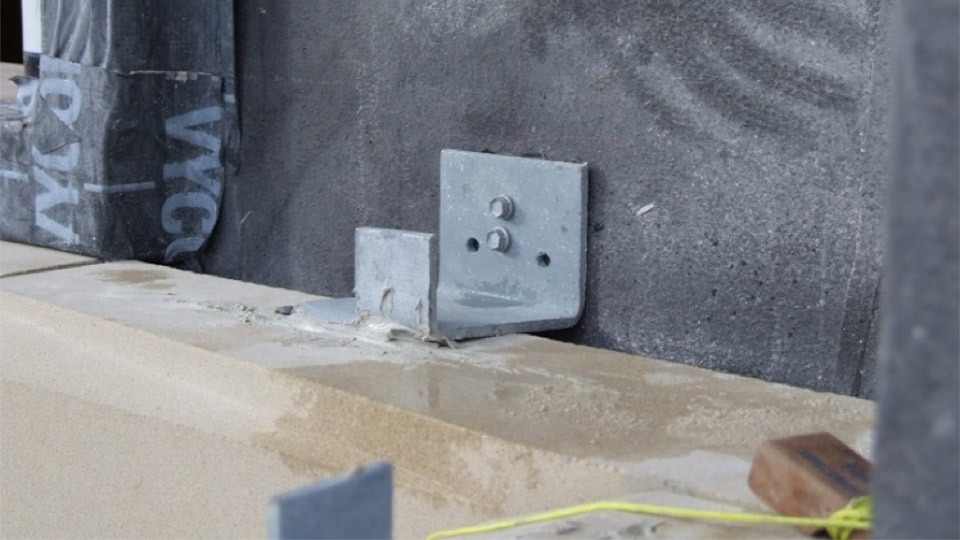 Figure 1. Typical anchored veneer using a split-tail anchor installed in a kerf cut into the bedded surface of the stone. In this case, the backup is a steel stud wall and mechanical anchorage to the backup is accomplished with self-tapping screws.
Figure 1. Typical anchored veneer using a split-tail anchor installed in a kerf cut into the bedded surface of the stone. In this case, the backup is a steel stud wall and mechanical anchorage to the backup is accomplished with self-tapping screws.
Anchored stone veneer is an attractive, durable exterior building envelope system and is widely used in commercial and upscale residential buildings. Natural stone units are typically of marble, granite, limestone or sandstone. Manufactured stone, also known as “cast stone”, often replicates the look of natural stones and can be a cost-effective alternate to natural stone. Regardless of the unit type, positive anchorage to the backup structure is required for anchored stone veneer. This is typically accomplished with stainless steel anchors which transmit out-of-plane forces such as wind or seismic to the backup. The vertical dead load of the anchored veneer is generally supported by a foundation ledge or shelf angle. Multi-story structures may have a shelf angle or support ledge at each floor line.
BUILDING CODE REQUIREMENTS
The 2015 International Building Code (IBC) identifies two categories of anchored stone veneer – a general class of anchored stone veneer not exceeding 10 inches in thickness and a slab-type veneer not exceeding 2 inches in thickness.
The IBC provides three prescriptive methods for the anchored veneer not exceeding 10 inches in thickness depending on whether the backup is concrete or masonry, wood stud, or steel-stud. All prescriptive methods require a cement grout at least 1 inch thick be placed between the backup and the stone veneer.
For the slab-type anchored veneer, the IBC specifies a minimum of four ties per unit with tie spacing not exceeding 24 inches. The maximum area of a unit is limited to 20 square ft. Veneer ties for slab-type veneer are required to resist, in tension or compression, two times the weight of the anchored veneer.
The IBC also references Building Code Requirements for Masonry Structures, which allows an alternate design method for anchored veneer using general principles of mechanics. This allows more flexibility to adapt the design of the veneer anchors to each unique veneer system. As you can imagine, the IBC’s prescriptive anchorage method for stones up to 10 inches thick is going to be overdesigned for typical veneers that are 2 ¼ to 4 inches in thickness.
DESIGN
The design of stone anchors is straightforward engineering. However, each component, and the connections between them, need to be evaluated for adequate strength and serviceability. For the design of the connection between the anchor and the stone, the engineer may rely on previous experience with a particular stone type or he/she may require that anchor pullout tests be performed on stone samples provided by the supplier. Anchor tests will provide a range of values for the ultimate pullout force of the particular anchor/stone combination, to which, appropriate factors of safety are then applied. In addition, ASTM C1242, Standard Guide for Selection, Design, and Installation of Dimension Stone Anchoring Systems, provides guidance on design considerations such as stress concentrations, thermal movement, stone durability and others.
 Figure 2. Typical anchor pullout test with split-tail anchor installed into a semi-circular edge kerf in Lyons Sandstone.
Figure 2. Typical anchor pullout test with split-tail anchor installed into a semi-circular edge kerf in Lyons Sandstone.
INSTALLATION
On most anchored stone veneer jobs, multiple anchors are needed to accommodate variable conditions such as outside and inside corners, cavity width variations, soffits, etc. The construction documents should clearly indicate the type of anchor intended for each condition. Minor adjustments can be made in the field to cope with construction tolerances, however if conditions encountered vary significantly from the design documents, a request for information is definitely needed.
CONCLUSIONS
Anchored stone veneer is a common material for exterior building envelopes, however the anchor system that worked on the last job should not be automatically assumed to work for the next. Each anchored stone veneer system is unique in nature and should be approached as such. Budget for engineering fees to design the anchorages for each job and plan on working closely with your engineer to make sure the constructability aspects are considered as well.